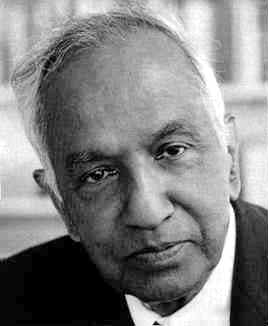
Chandra was one of the great astrophysicists of the 20th century. He was famous for spending a decade on one branch of physics, writing the definitive monograph on the subject, and then moving on to dominate yet another field. The Chandrasekhar Limit expresses the maximum mass a star of a particular composition can have before collapsing under its own weight; the Chandrasekhar limit for white dwarf (electron degenerate) stars is around 1.4 solar masses, while the limit for neutron degenerate matter is slightly higher. If the star is over the limit, it can "tend .. towards a completely collapsed state", in modern terms a black hole. Chandra discovered the limit during a sea voyage from India to England in 1930. In a famous confrontation at the Royal Astronomical Society on 1935 Jan 11, Sir Arthur Eddington, the astronomical titan of his time, said `I think there should be a law of Nature to prevent a star from behaving in this absurd way!' (Observatory LVIII, p 38). Chandra left Cambridge for Chicago, but lived to see his vindication.
| 1910 Oct 19 | Born in Lahore to Sita Balakrishnan and Chandrasekhara Subrahmanya Ayyar. |
| 1918 | Moved to Madras |
| 1925-1930 | B.Sc. Physics student at Presidency College, Madras |
| 1930 | Sea voyage to England; discovers C. Limit |
| 1929-1939 | 1: Studies of White Dwarf Stars |
| 1930-1933 | Ph.D. student at Cambridge, under R.H. Fowler |
| 1931-1932 | Papers on white dwarf stars |
| 1935 Jan 11 | Eddington argues with Chandra at the RAS |
| 1936 Sep | Married Lalitha Doraiswamy |
| 1937 Jan | Moved to Yerkes Observatory, University of Chicago |
| 1939 | Publishes Introduction to the Study of Stellar Structure |
| 1938-1943 | 2: Studies of Stellar Dynamics |
| 1942 | Publishes Principles of Stellar Dynamics |
| 1943-1950 | 3: Studies of Radiative Transfer |
| 1950 | Publishes Radiative Transfer |
| 1952 | Editor of Ap.J. (till 1971) |
| 1952-1961 | 4: Studies of Hydrodynamic and Hydromagnetic Stability |
| 1961 | Publishes Hydrodynamic and Hydromagnetic Stability |
| 1961-1968 | 5: Studies of Figures of Equilibrium |
| 1968 | Publishes Ellipsoidal Figures of Equilibrium |
| 1962-1971 | 6: Studies of GR and Relativistic Astrophysics |
| 1974-1983 | 7: Studies of the Mathematical Theory of Black Holes |
| 1983 | Publishes The Mathematical Theory of Black Holes |
| 1983 | Nobel prize for physics |
| 1995 Aug 21 | Died in Chicago |